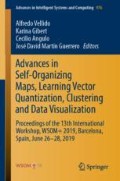Abstract
The complexity of urban segregation challenges researchers to develop powerful and complex mathematical tools for assessing it. With more and more fine-grained and massive data becoming available these last years, individual-based models are now made possible in practice. Very recently, a mathematical object called multiscalar fingerprint [1], containing all possible and all scale individual trajectories in a city, was introduced. Here, we use clustering combined with specific measures for assessing features contributions to clusters, to explore this complex object and to single out hotspots of segregation. We illustrate how clustering allows to see where, how and to which extent segregation occurs.
Access this chapter
Tax calculation will be finalised at checkout
Purchases are for personal use only
References
Randon-Furling J, Olteanu M, Lucquiaud A (2018) From urban segregation to spatial structure detection. Urban Analytics and City Science, Environment and Planning B
Reardon SF, Firebaugh G (2002) Measures of multigroup segregation. Sociol Methodol 32(1):33–67
Kramer MR, Cooper HL, Drews-Botsch CD, Waller LA, Hogue CR (2010) Do measures matter? comparing surface-density-derived and census-tract-derived measures of racial residential segregation. Int J Health Geogr 9(1):29
Hong S, O’Sullivan D, Sadahiro Y (2014) Implementing spatial segregation measures in R. PLOS ONE 9:1–18
Openshaw S (1984) The modifiable areal unit problem. University of East Anglia
Reardon SF, Matthews SA, O’Sullivan D, Lee BA, Firebaugh G, Farrell CR, Bischoff K (2008) The geographic scale of metropolitan racial segregation. Demography 45(3):489–514
Clark WAV, Andersson E, Östh J, Malmberg B (2015) A multiscalar analysis of neighborhood composition in Los Angeles, 2000–2010: a location-based approach to segregation and diversity. Ann Assoc Am Geogr 105(6):1260–1284
Spielman SE, Logan JR (2013) Using high-resolution population data to identify neighborhoods and establish their boundaries. Ann Assoc Am Geogr 103(1):67–84
Fowler C (2016) Segregation as a multiscalar phenomenon and its implications for neighborhood-scale research: the case of south seattle 1990–2010. Urban Geogr 37(1):1–25
Olteanu M, Randon-Furling J, Clark W (2019, to appear) Spatial analysis in high resolution geo-data. In: ESANN Proceedings. Preprint available on demand
Lamirel J-C, Dugue N, Cuxac P (2016) New efficient clustering quality indexes. In: International joint conference on neural networks, pp 3649–3657
Lamirel J-C, Mall R, Cuxac P, Safi G (2011) Variations to incremental growing neural gas algorithm based on label maximization. In: International joint conference on neural networks, pp 956–965
James M (1967) Some methods for classification and analysis of multivariate observations. In: Proceedings of the fifth Berkeley symposium on mathematical statistics and probability, vol 1, pp 281–297
Fritzke B (1995) A growing neural gas network learns topologies. In: Advances in neural information processing systems, pp 625–632
Acknowledgments
The authors wish to thank W. Clark (UCLA) and J. Randon-Furling (Université Panthéon Sorbonne) for the many discussions on the topics of spatial segregation and individual trajectories analysis.
Author information
Authors and Affiliations
Corresponding author
Editor information
Editors and Affiliations
Rights and permissions
Copyright information
© 2020 Springer Nature Switzerland AG
About this paper
Cite this paper
Olteanu, M., Lamirel, JC. (2020). When Clustering the Multiscalar Fingerprint of the City Reveals Its Segregation Patterns. In: Vellido, A., Gibert, K., Angulo, C., Martín Guerrero, J. (eds) Advances in Self-Organizing Maps, Learning Vector Quantization, Clustering and Data Visualization. WSOM 2019. Advances in Intelligent Systems and Computing, vol 976. Springer, Cham. https://doi.org/10.1007/978-3-030-19642-4_14
Download citation
DOI: https://doi.org/10.1007/978-3-030-19642-4_14
Published:
Publisher Name: Springer, Cham
Print ISBN: 978-3-030-19641-7
Online ISBN: 978-3-030-19642-4
eBook Packages: Intelligent Technologies and RoboticsIntelligent Technologies and Robotics (R0)

